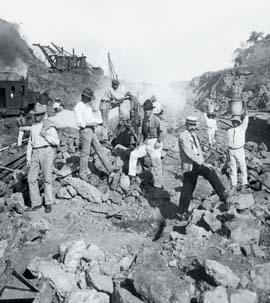Guest columnist Caroline Lieffers reflects on the legacy of Christian communities 100 years after construction began on the Panama Canal.
When the Panama Canal opened in August 1914, it was hailed as a triumph of engineering, fulfilling the long-held dream of uniting the Atlantic and Pacific oceans. “Faith in American genius has removed mountains [and] built an inland sea,” wrote historian Ira Bennett in 1915. But another kind of faith was also critical to the canal’s construction – the Christian faith of many of its labourers.
About 45,000 foreign workers provided much of the labour that built the Panama Canal. They came from around the world, but the largest number – nearly 20,000 – were from Barbados. They toiled in the hot sun, endured dangerous dynamiting and catastrophic landslides, and struggled through rough living conditions and Jim Crow-style racial discrimination, all for as little as a dollar a day.
The work was exhausting and hazardous, and thousands of workers experienced serious illnesses and injuries. Registers in the United States National Archives document crushed limbs, wounded eyes and blows to the head, the kinds of injuries that left men permanently disabled. When construction started there was no compensation for sick or injured labourers. Policies improved over time, but these men often struggled to support themselves and their families.
In this dehumanizing context where danger and poverty loomed, faith was a lifeline, giving purpose, community and hope. The Workman, a local Afro-Caribbean newspaper, listed dozens of church services in every issue, and churches were a key place to make connections and organize support for people experiencing illness or disability. Church groups would frequently visit people living in Panama’s “leper colony,” for example, often providing concerts for their entertainment.
Scripture also offered stories and language that disabled workers could use to advocate for themselves. In 1916 a group of six men “hurted on the P.C.,” as they put it, wrote to U.S. President Woodrow Wilson about their poor treatment.
They were living in poverty and some needed new artificial limbs so they could get back to work. “My Lord, King Pharah had his time, in treating The poor just like this, but he never thought his time would some to Such an end, and Such A place,” they wrote. Drawing on biblical stories of the Israelites’ oppression in Egypt, they recognized they were inheritors of a long tradition of exploited labour, and hoped a greater justice would prevail.
Even if administrators did not provide the support these men needed, their community might have stepped in to help. A Workman editorial in 1925 affirmed that despite “great suffering and want,” the labourers and their families would never “allow their respective countrymen to walk the streets of a foreign country and beg.” A “Colored Cripples Association” founded in 1918 also collected dues that could be used to provide loans, help members purchase artificial limbs or give small allowances in cases of sickness or death.
Faith could also help men make sense of the tragedies they had witnessed, often decades after the fact. In the early 1980s Panamanian American filmmaker Roman Foster sought out survivors from the construction for a documentary, Diggers. Many of them testified to the fear they faced, the difficulty of the work and the stress of watching friends be injured or killed.
In this dehumanizing context where danger and poverty loomed, faith was a lifeline, giving purpose, community and hope.

Survivor John W. Bowen reflected, “To be truthful, I tried to push my feelings in the corner for many reasons…. The fact still remains much of my blood that has been spilt, and nobody cared about it. But I’m still alive. Under God’s care. And will always remember that the good that you do lives with you. So says the Good Book.”
Today a grey wooden building in Panama City is home to the Afro-Antillean Museum of Panama, which honours the people who were so integral to the Canal’s success. Fittingly, this building was once a place of worship – the Christian Mission Church founded by Barbadian Protestants in 1909. It remains the heart of a thriving community, sustained by volunteers, visitors and donations, and it holds the memories of these workers and their abiding faith.
Caroline Lieffers is an associate professor of history at The King’s University in Edmonton. Read more at FaithToday.ca/HistoryLesson. Photo of Panama Canal workers: Everett Collection / 1906